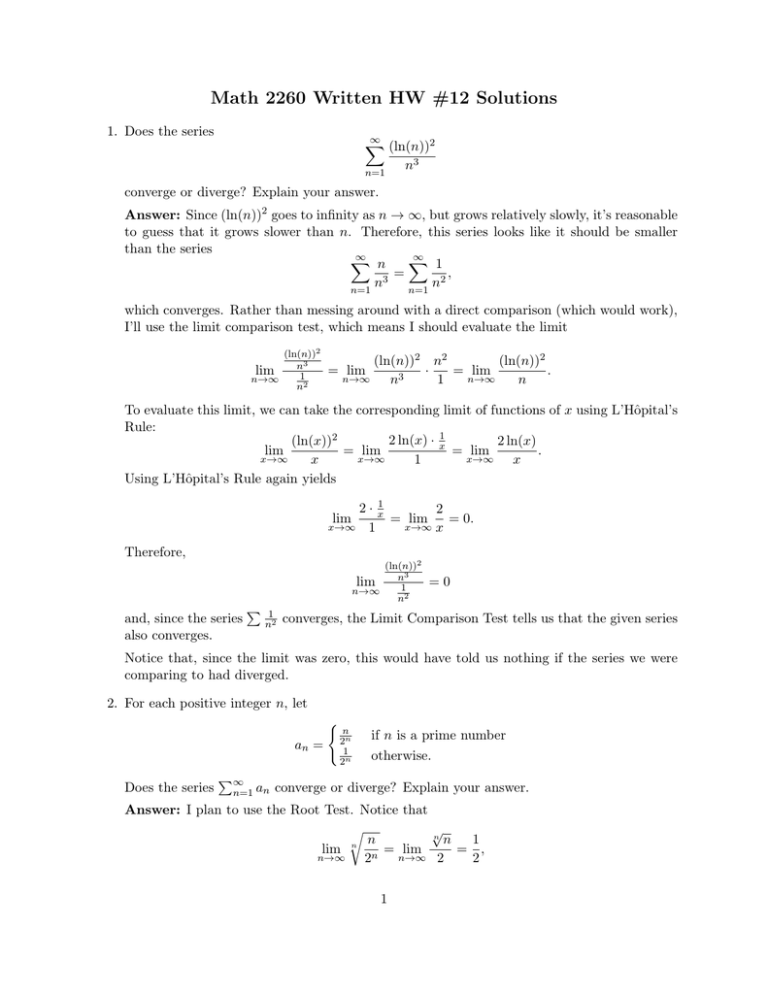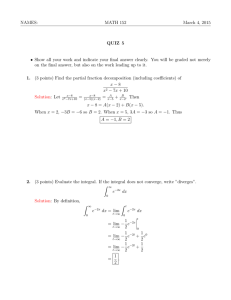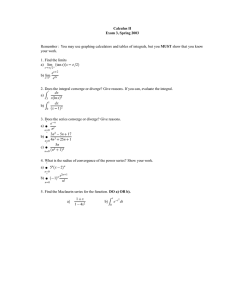Math 2260 Written HW #12 Solutions
advertisement

Math 2260 Written HW #12 Solutions 1. Does the series ∞ X (ln(n))2 n=1 n3 converge or diverge? Explain your answer. Answer: Since (ln(n))2 goes to infinity as n → ∞, but grows relatively slowly, it’s reasonable to guess that it grows slower than n. Therefore, this series looks like it should be smaller than the series ∞ ∞ X X n 1 = , 3 n n2 n=1 n=1 which converges. Rather than messing around with a direct comparison (which would work), I’ll use the limit comparison test, which means I should evaluate the limit (ln(n))2 n3 lim 1 n→∞ n2 (ln(n))2 n2 (ln(n))2 · = lim . n→∞ n→∞ n3 1 n = lim To evaluate this limit, we can take the corresponding limit of functions of x using L’Hôpital’s Rule: 2 ln(x) · x1 (ln(x))2 2 ln(x) lim = lim = lim . x→∞ x→∞ x→∞ x 1 x Using L’Hôpital’s Rule again yields 2 · x1 2 = lim = 0. x→∞ 1 x→∞ x lim Therefore, (ln(n))2 n3 lim 1 n→∞ n2 and, since the series also converges. P 1 n2 =0 converges, the Limit Comparison Test tells us that the given series Notice that, since the limit was zero, this would have told us nothing if the series we were comparing to had diverged. 2. For each positive integer n, let ( an = Does the series P∞ n=1 an n 2n 1 2n if n is a prime number otherwise. converge or diverge? Explain your answer. Answer: I plan to use the Root Test. Notice that r √ n 1 n n n = lim = , lim n→∞ 2n n→∞ 2 2 1 since limn→∞ √ n n = 1, as we discussed in class. Likewise, r 1 1 n 1 = lim = . lim n n→∞ 2 n→∞ 2 2 √ Thus, no matter if n is prime or not, we see that n an is approaching words, √ 1 lim n an = . n→∞ 2 Since 12 < 1, the Root Test tells us that the series converges. 3. Does the series ∞ X (−1)n+1 n=2 1 2 as n → ∞; in other 1 n ln(n) converge absolutely, converge conditionally, or diverge? Explain your answer. 1 Answer: First, notice that the terms n ln(n) are positive, decreasing, and approaching zero, so the hypotheses of the Alternating Series Test are satisfied, so we know that the series converges. Therefore, we just need to determine whether or not it converges absolutely, which is to say, whether or not the series ∞ ∞ X X 1 1 n+1 (−1) = n ln(n) n ln(n) n=2 n=2 converges. But now the thing to notice is that the terms look like a function that’s easy to integrate, so the Integral Test will come in handy: Z b Z ∞ 1 1 dx = lim dx. b→∞ 2 x ln x x ln(x) 2 Let u = ln(x). Then du = x1 dx and, since u(2) = ln(2) and u(b) = ln(b), the above integral can be written as Z ln(b) h iln(b) du lim = lim ln(u) = lim (ln(ln(b)) − ln(ln(2))) b→∞ ln(2) u b→∞ b→∞ ln(2) Although it gets big incredibly slowly, limb→∞ ln(ln(b)) = ∞, so the above integral diverges. (To emphasize just how incredibly slowly ln(ln(x)) goes to infinity, look at the below graph of the function. Even for x = 10100 [a.k.a. a googol], it’s still smaller than 5.5!) 5.44 5.42 5.40 5.38 2 ´ 1099 4 ´ 1099 2 6 ´ 1099 8 ´ 1099 1 ´ 10100 P Therefore, since the integral diverges, the Integral Test implies that the series ∞ n=2 diverges as well, which means that the original series only converges conditionally. 3 1 n ln(n)





